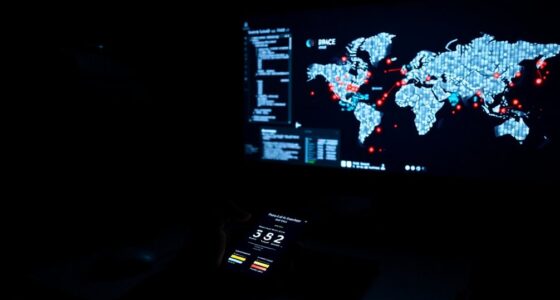
As cyber threats evolve, you can’t ignore the rise of Typhoon cyber groups, which are wreaking havoc on critical infrastructure worldwide. These advanced persistent threat actors, linked to China, have become notorious for their sophisticated cyber espionage and disruptive attacks. Groups like Salt Typhoon and Volt Typhoon employ distinct tactics, targeting vital sectors such as telecommunications, energy, finance, and government. Their activities not only disrupt services but also gather sensitive intelligence, posing a significant risk to national security.
The rise of Typhoon cyber groups threatens critical infrastructure, employing sophisticated tactics to disrupt services and gather sensitive intelligence.
The state sponsorship behind these groups plays a crucial role in their operations. Their actions often align with geopolitical objectives, making them a tool for state interests. The sophisticated nature of their attacks is evident in their use of advanced techniques, such as supply chain compromises and zero-day vulnerabilities. You can’t underestimate the impact of these techniques; they allow attackers to infiltrate networks and remain undetected for extended periods.
Salt Typhoon, for instance, primarily targets telecommunications companies. By intercepting sensitive communications, they gain valuable intelligence. Their arsenal includes custom-built malware and tools designed for stealthy operations. They exploit vulnerabilities in VPNs, firewalls, and cloud infrastructures to gain initial access, employing Living Off the Land tactics to blend their activities with normal network operations. Recently, they leveraged a seven-year-old Cisco vulnerability to breach systems without raising alarms. This highlights the impact of vulnerabilities that can be exploited to gain unauthorized access.
Volt Typhoon’s operations are equally concerning. This group focuses on U.S. critical infrastructure, particularly in the energy and transportation sectors. Their state-sponsored nature drives them to conduct extensive reconnaissance before launching attacks, ensuring they understand target networks thoroughly. They utilize legitimate system tools, known as Living Off the Land Binaries, to evade detection, making it increasingly difficult for cybersecurity defenses to respond effectively.
The global reach of Typhoon groups is alarming, with attacks reported across multiple countries, including the United States. The economic impact of these disruptions can be severe, leading to instability and potential breaches of national security. Their stealthy operations and sophisticated techniques emphasize the urgent need for enhanced cybersecurity measures.
As these groups continue to evolve, you must stay informed and vigilant, recognizing the threats they pose to your critical infrastructure. Understanding their tactics and motivations is the first step in fortifying defenses and mitigating the chaos unleashed by these cyber typhoons.









